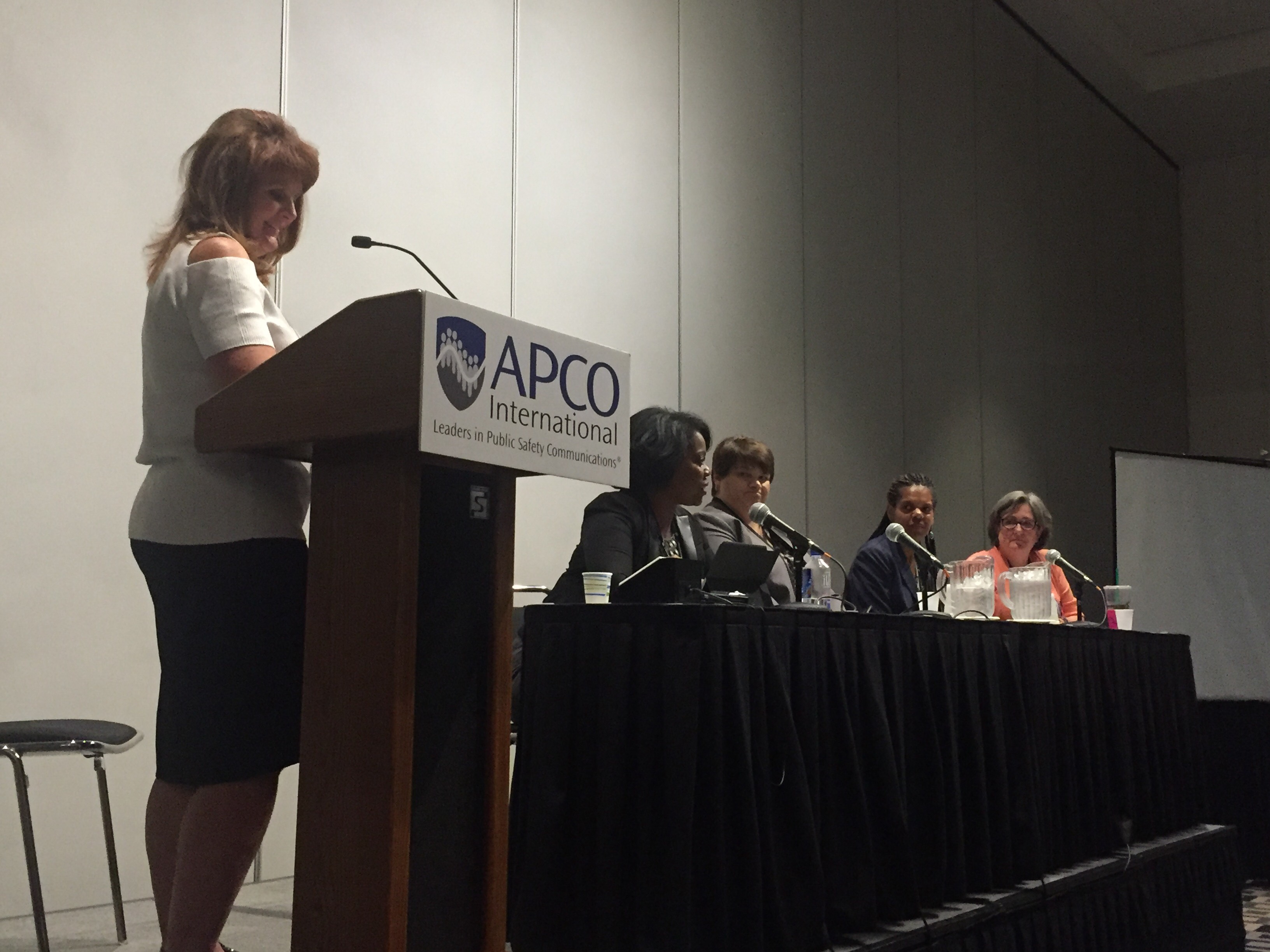Monday Wrap-Up
![]() Print this Article | Send to Colleague
Print this Article | Send to Colleague
Women in Public Safety Communications
Presenters: Gigi Smith, Karima Holmes, Angela Bowen, Athena Butler and Mary Sue Robey

This session was presented by a panel of five trailblazing women in public safety communications with a total of 126 years of experience. Geared towards other women in public safety communications, this session discussed various challenges faced by women working in public safety communications, offered advice on how and why to become involved in local and national associations such as APCO, encouraged women to take on more leadership roles and explained the importance of networking with other female public safety professionals. Based on the nearly 100% attendance, these are topics other women want to talk about.
Although each panelist agreed on the importance of maintaining balance and wellness, each has different practices to achieve these. One practices yoga and doesn't skimp on sleep, one spends time with her grandson on weekends, one became a fitness instructor after losing a lot of weight and another takes an hour a day doing something she loves, like cooking or gardening.
Recognizing that most women hate conflict, Gigi Smith encouraged participants to have courage. "Have those conversations. Be direct. Be assertive. And carry your confidence."
This presentation will be repeated Tuesday at 1:30 p.m.
- Christina Dravis
OEC: Initiatives and Their Impact on Emergency Communications
Presenters: Ron Hewitt, Eric Runnels, Daniel Moore, Michael Garcia and Jeffery Wobbleton
The Department of Homeland Security Office of Emergency Communications has launched several initiatives to bolster interoperability in emergency communications. This session was presented by a panel to discuss the impact these would have on public safety.
The National Emergency Communications Plan (NECP) was updated in 2014 for broadband and NG9-1-1. The update includes adding LTE to the LMR world. The updates focus on interoperability of field services, programs and devices with the NG9-1-1 program and devices of the PSAPs.
The NECP is attempting to achieve interoperability at all levels of communications: local, state and national. Reviews of several planned events helps OEC evaluate the plan for quality. Areas of concern were voice, data and video. Events from 2010 to 2016 were compared to see if improvements were made and how it impacted operations.
Processes reviewed included planning, event specific, public alert and warning and WEA.
Cleveland, Ohio, discussed operations during the Republican National Convention, and a similar review of the operations was also completed.
The National Governors association (NGA) gave a briefing on their assistance in getting information from OEC to the state governments. The goal of the NGA is to assist with governance policies to promote OEC efforts.
SAFECOM was discussed as a program to help locals to achieve the interoperability required to reach their goals. A new survey will be conducted on the Federal Register to capture comments on SAFECOM.
- Michael A. Scales
FCC Update
Presenter: David Furth
This session provided an overview of the public safety issues presently before the Federal Communications Commission (FCC). Deputy Chief Furth began with an update on 9-1-1 wireless location accuracy, describing a number of milestones in achieved within the last year. He then described the FCC’s role in the FirstNet state opt-out process, which consists of evaluating whether state alternative plans for a Radio Access Network meet the interoperability requirements of the law.
Next, Furth discussed an investigation into a nationwide AT&T 9-1-1 outage that occurred in March 2017, noting that the FCC will hold a related workshop in September. Furth also provided updates on the FCC’s tracking of text-to-911 deployment, recent action to permit carriers to transition from TTY to Real-time Text (RTT) technologies, and the FCC’s annual report to Congress on 9-1-1 fee diversion. Before closing, Furth mentioned several issues that are still pending at the FCC, such as the use of non-service initialized devices for emergency calls, public safety use of the 4.9 GHz band, and the 800 MHz spectrum rebanding process.
- Mark Reddish
Prospect of Federal Legislation for NG9-1-1
?Presenter: Jeff Cohen
?
On the day the APCO Project 43 report was officially released, Jeff Cohen’s opening remarks that "modernizing the nation’s 9-1-1 system is essential to the security of our citizens and the first responders who serve them", and "...the need for federal legislation to achieve that goal", were perfectly timed.
NG9-1-1 is an extremely complex solution, ?including? lots of players with differing political, technical and operational points of view. Given ?how complex it is?, federal legislation and new funding models, including grants, will likely be required to drive it to completion.
For congress to agree to ?pass legislation?, practitioners and providers must convince them ?that? the following elements ?will? be included:
• Agreed-upon governance ?(do not allow silos of expertise to develop ?)?
• Ensure interoperability (everyone can use it)
• Encourage innovation (both small and large providers involved)
• Must leverage widely-deployed consumer solutions
• A funding model that does not allow for 9-1-1 funds to be diverted
• A common definition regarding what NG9-1-1 actually is
This last point regarding the common definition is moving forward. Project 43 and the recent meeting between APCO President Cheryl Greathouse and NENA President Rob McMullen are taking great steps towards making the common definition a reality.
- Matthew Schreiner
